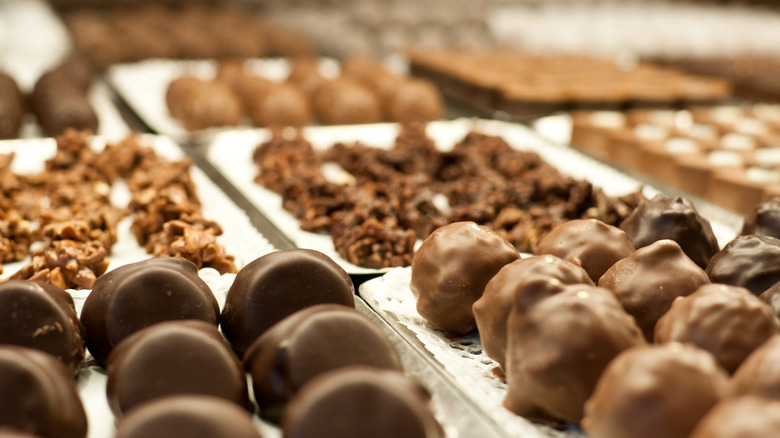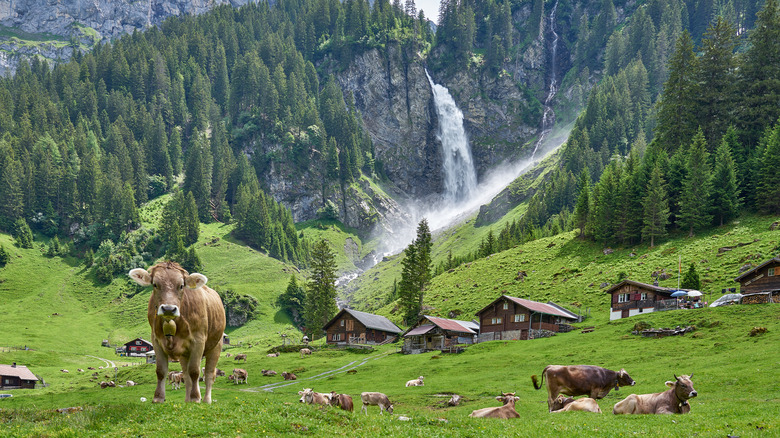The Country That Eats The Most Chocolate
It probably comes as no surprise to most people that the world loves chocolate. Indeed, Dame Cacao reports that worldwide chocolate consumption is expected to reach 7.5 million tons in 2024 (that's an average of almost two pounds per person for the year). Of course, when we're talking about averages, it doesn't mean that everyone's cocoa fixes are the same. As of 2022, the four largest chocolate-producing countries were Germany, Belgium, Italy, and Poland, all of which consume their fair share of the sweet every year. However, no one eats as much chocolate as the Swiss.
According to data presented by the World Population Review, Switzerland consumes an average of around 19.4 pounds of chocolate per person per year as of 2024. Its next-door neighbor, Austria, comes in a close second, consuming 17.8 pounds. Among the top chocolate producers, Germany consumes 17.4 pounds annually, Belgium is surprisingly much lower at 12.3 pounds, Poland sits just above that at 12.5 pounds, while Italy does not rank in the top 23 chocolate-eating countries at all. As for the United States, it consumes about 9.9 pounds of chocolate yearly, putting it in 18th place.
What Switzerland has done for the chocolate-making world
It's clear that the Swiss are proud of their homeland's history of chocolate-making, and naturally, they are happy to partake generously in what their country excels at. While Switzerland certainly didn't invent chocolate (that honor goes to the ancient Latin American Olmec people), the Swiss have contributed significantly to the cocoa table. Chocolate first arrived in Switzerland in 1615 as drinking chocolate, and was primarily enjoyed in this form until the Industrial Revolution, when solid chocolate was created. In 1819, François-Louis Cailler built the first automated chocolate factory, designed to produce chocolate on a larger scale. Today, the Cailler brand still exists and is the oldest Swiss chocolate brand in the country.
Perhaps the most significant claim to fame for Switzerland in the realm of chocolate is that the country is responsible for creating milk chocolate. In an effort to reduce the bitter taste of chocolate (which the French tend to gravitate towards), Swiss chocolatier Daniel Peter combined cocoa with butter, sugar, and condensed milk to create a sweeter, creamier version of chocolate, delighting many. Other Swiss chocolate makers followed suit, taking advantage of the country's large dairy industry to begin mass production of what became known as milk chocolate. This process also reduced the cost of chocolate treats by cutting down on the amount of expensive cacao needed. Great chocolate at a great price clearly was a recipe for success.
Got milk? Swiss chocolatiers do
Along with luxury watches, banking, and Alpine cheese, Switzerland has long been synonymous with excellent chocolate, with some of its most popular brands being widely recognized around the globe, such as Lindt and Toblerone. These two brands are known for their luxuriously rich and velvety texture, which is a result of Switzerland's practice of using a higher milk-to-cacao ratio than other global chocolate brands.
In fact, it was Rodolphe Lindt himself who created the technique called "conching" that essentially makes chocolate melt in the mouth. It's also worth noting that the country's milk is reputed to be some of the richest and best in the world. Strict conditions on how cows are raised and treated lead to the excellent health of the animals, which are required to have plenty of outdoor space for exercise and fresh air, clean water, and ample pasture grazing.
This rich milk goes into not just the aforementioned Swiss chocolate brands, but also the country's many large chocolate manufacturers and smaller-scale chocolate makers. And it's not just happy cows you'll find in this beautifully picturesque country; the platform NiceRX analyzed 50 countries and ranked Switzerland as the happiest country in the world in 2022. It's not far-fetched to assume this has something to do with daily chocolate consumption, which certainly puts a smile on our face.



